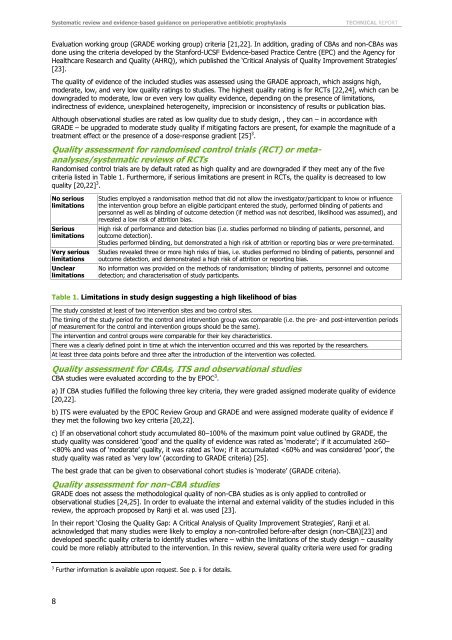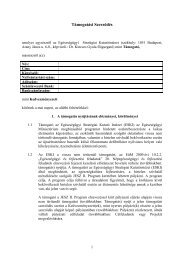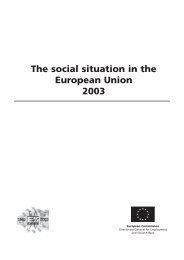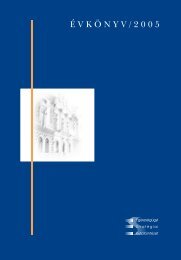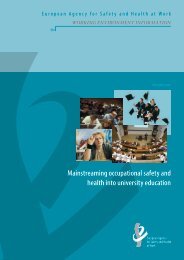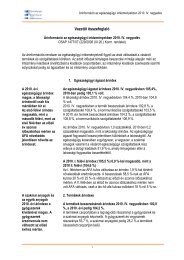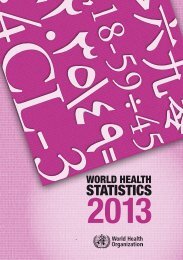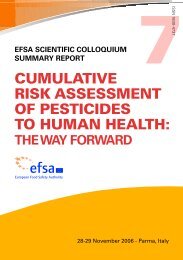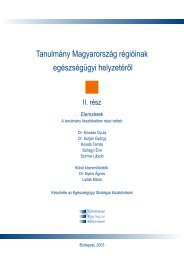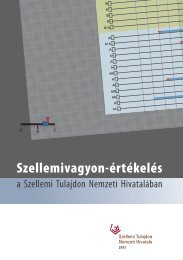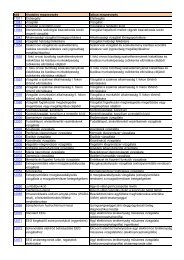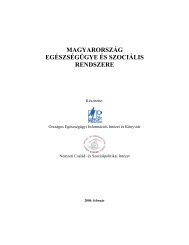Systematic review and evidence- based guidance ... - ECDC - Europa
Systematic review and evidence- based guidance ... - ECDC - Europa
Systematic review and evidence- based guidance ... - ECDC - Europa
Create successful ePaper yourself
Turn your PDF publications into a flip-book with our unique Google optimized e-Paper software.
<strong>Systematic</strong> <strong>review</strong> <strong>and</strong> <strong>evidence</strong>-<strong>based</strong> <strong>guidance</strong> on perioperative antibiotic prophylaxisTECHNICAL REPORTEvaluation working group (GRADE working group) criteria [21,22]. In addition, grading of CBAs <strong>and</strong> non-CBAs wasdone using the criteria developed by the Stanford-UCSF Evidence-<strong>based</strong> Practice Centre (EPC) <strong>and</strong> the Agency forHealthcare Research <strong>and</strong> Quality (AHRQ), which published the ‘Critical Analysis of Quality Improvement Strategies’[23].The quality of <strong>evidence</strong> of the included studies was assessed using the GRADE approach, which assigns high,moderate, low, <strong>and</strong> very low quality ratings to studies. The highest quality rating is for RCTs [22,24], which can bedowngraded to moderate, low or even very low quality <strong>evidence</strong>, depending on the presence of limitations,indirectness of <strong>evidence</strong>, unexplained heterogeneity, imprecision or inconsistency of results or publication bias.Although observational studies are rated as low quality due to study design, , they can – in accordance withGRADE – be upgraded to moderate study quality if mitigating factors are present, for example the magnitude of atreatment effect or the presence of a dose-response gradient [25] 3 .Quality assessment for r<strong>and</strong>omised control trials (RCT) or metaanalyses/systematic<strong>review</strong>s of RCTsR<strong>and</strong>omised control trials are by default rated as high quality <strong>and</strong> are downgraded if they meet any of the fivecriteria listed in Table 1. Furthermore, if serious limitations are present in RCTs, the quality is decreased to lowquality [20,22] 3 .No seriouslimitationsSeriouslimitationsVery seriouslimitationsUnclearlimitationsStudies employed a r<strong>and</strong>omisation method that did not allow the investigator/participant to know or influencethe intervention group before an eligible participant entered the study, performed blinding of patients <strong>and</strong>personnel as well as blinding of outcome detection (if method was not described, likelihood was assumed), <strong>and</strong>revealed a low risk of attrition bias.High risk of performance <strong>and</strong> detection bias (i.e. studies performed no blinding of patients, personnel, <strong>and</strong>outcome detection).Studies performed blinding, but demonstrated a high risk of attrition or reporting bias or were pre-terminated.Studies revealed three or more high risks of bias, i.e. studies performed no blinding of patients, personnel <strong>and</strong>outcome detection, <strong>and</strong> demonstrated a high risk of attrition or reporting bias.No information was provided on the methods of r<strong>and</strong>omisation; blinding of patients, personnel <strong>and</strong> outcomedetection; <strong>and</strong> characterisation of study participants.Table 1. Limitations in study design suggesting a high likelihood of biasThe study consisted at least of two intervention sites <strong>and</strong> two control sites.The timing of the study period for the control <strong>and</strong> intervention group was comparable (i.e. the pre- <strong>and</strong> post-intervention periodsof measurement for the control <strong>and</strong> intervention groups should be the same).The intervention <strong>and</strong> control groups were comparable for their key characteristics.There was a clearly defined point in time at which the intervention occurred <strong>and</strong> this was reported by the researchers.At least three data points before <strong>and</strong> three after the introduction of the intervention was collected.Quality assessment for CBAs, ITS <strong>and</strong> observational studiesCBA studies were evaluated according to the by EPOC 3 .a) If CBA studies fulfilled the following three key criteria, they were graded assigned moderate quality of <strong>evidence</strong>[20,22].b) ITS were evaluated by the EPOC Review Group <strong>and</strong> GRADE <strong>and</strong> were assigned moderate quality of <strong>evidence</strong> ifthey met the following two key criteria [20,22].c) If an observational cohort study accumulated 80–100% of the maximum point value outlined by GRADE, thestudy quality was considered ‘good’ <strong>and</strong> the quality of <strong>evidence</strong> was rated as ‘moderate’; if it accumulated ≥60–


